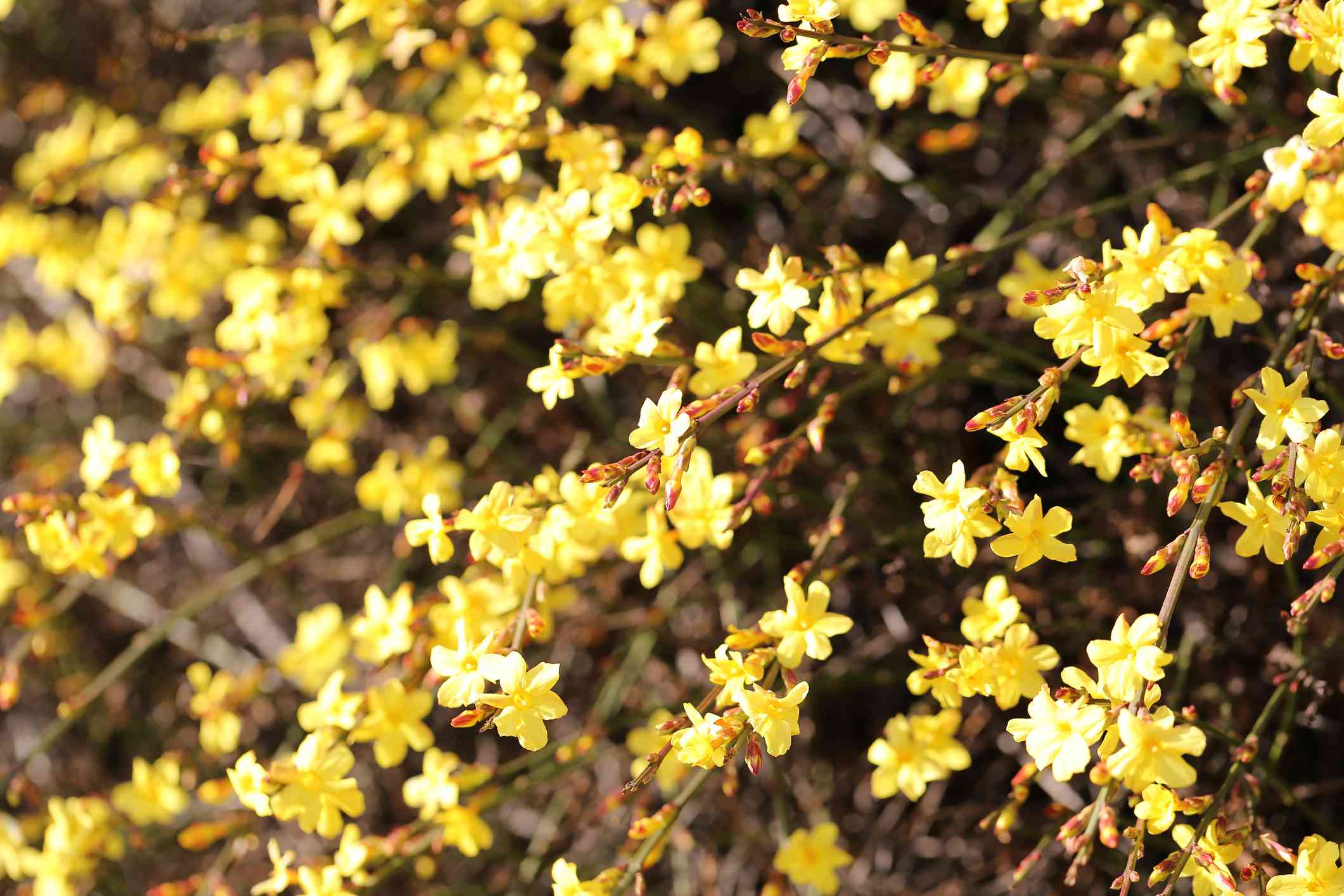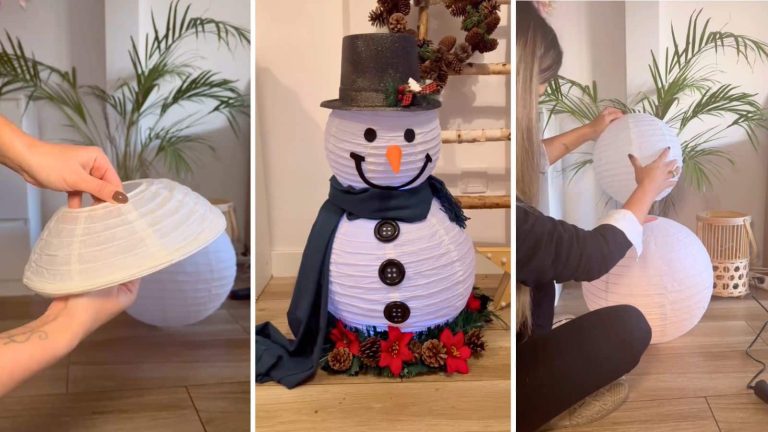
:max_bytes(150000):strip_icc():format(jpeg)/GettyImages-470927927-3c21f2b10207480ab02d39e411d80b0d.jpg)
| Common Name | Winter jasmine |
| Botanical Name | Jasminum nudiflorum |
| Family | Oleaceae |
| Plant Type | Groundcover, shrub, vine |
| Mature Size | 4 ft. tall, 4 ft. wide (as a shrub); 10-15 ft. tall, 3-6 ft. wide (as a vine) |
| Sun Exposure | Full, partial |
| Soil Type | Loamy, moist but well-drained, sandy |
| Soil pH | Neutral, acidic |
| Bloom Time | Winter, spring |
| Flower Color | Yellow |
| Hardiness Zones | 6-10, USDA |
| Native Area | Asia |
SzabolcsKiss / Getty Images
BasieB / Getty Images
Winter Jasmine Care
Winter jasmine is considered low-maintenance, and once established, it requires very little upkeep. Here are the basic requirements for growing winter jasmine in your garden:
- Provide winter jasmine with eight to 10 hours of direct or bright indirect light.
- Plant in a location with loamy, well-draining soil for optimal growth.
- Prune to control growth habit and shape if desired.
Want more gardening tips? Sign up for our free gardening newsletter for our best-growing tips, troubleshooting hacks, and more!
Light
Winter jasmine requires plenty of bright light to grow. Choose a location that receives several hours of direct sunlight or bright, indirect light. Shady locations will lead to weak and stunted growth and restricted blooms, and plants are at a higher risk of being overwatered.
Soil
This hardy plant can tolerate a wide range of soils but does best in loamy and well-drained soil. The only soil you need to avoid with winter jasmine is clay or poorly drained soil since it does not like wet conditions. Its ability to thrive in poor-quality soils makes winter jasmine a popular choice for sites with infertile soil or for erosion control.
Water
Established winter jasmine plants are relatively drought-tolerant and usually don’t need to be watered outside of regular rainfalls. They are susceptible to overwatering and root rot, but as long as they are planted in well-draining soil, the risk of overwatering is low. Newly transplanted winter jasmine should be watered regularly (approximately once a week) until established.
Temperature and Humidity
Winter jasmine is hardy in USDA zones 6 to 10. It requires several weeks of cool temperatures (60 degrees Fahrenheit or lower) to bloom in the late winter and spring. It can tolerate temperatures as low as -5 degrees Fahrenheit (-15 degrees Celsius).
Fertilizer
Fertilizer is generally unneeded for winter jasmine plants. That said, they benefit from growing in fertile soils, so amending the soil with fresh compost every year or two is a great way to ensure that the plant is getting plenty of nutrients.
Pruning
Pruning is not required for the plant’s health but may be desired to help control its size and spread. Since winter jasmine blooms on old wood, it should only be pruned in the early spring once it has finished flowering. This will help the buds set properly for the following year’s blooms.
When pruning, remove any diseased or spindly branches and then shape as desired. Never prune more than 30 percent of the plant’s growth at one time.
Propagating Winter Jasmine
Thanks to its creeping growth habit, winter jasmine is easy to propagate using several different methods. The simplest one is layering, which requires little to no effort other than ensuring that a portion of the stem is in contact with the ground. Besides layering, winter jasmine also readily propagates by stem cuttings and can be grown by seed. Regardless of the method, it is best to propagate winter jasmine in the spring after it has bloomed.
How to Propagate Winter Jasmine by Layering
- Take a long branch from your winter jasmine plant and bend it towards the ground, laying the end flat on the soil.
- Cover a portion of the stem with soil (at least a couple of inches back from the growth tip) and secure the branch down using a rock, brick, or wire.
- The stem will begin developing roots where it comes in contact with the soil. Once roots have developed, the stem can be cut from the main plant and transplanted elsewhere. This should take a few weeks.
How to Propagate Winter Jasmine by Cuttings:
- Using a clean, sharp pair of pruning shears, take stem cuttings from the plant after it has finished blooming.
- Remove the leaves from the bottom half of each cutting and prepare a container with loamy, well-drained potting soil.
- Water the soil and allow the excess water to drain from the pot. The potting mix should be moist but not soaked before the cuttings are added.
- Dip the cut end of the stem in rooting hormone and press the stem down into the soil.
- Place the cuttings in a warm location that receives several hours of bright, indirect light.
- Once the cuttings have roots, the plants can be transplanted back into the garden.
How to Grow Winter Jasmine From Seed
Winter jasmine is best grown from established plants purchased from your local nursery, but they can be started from seed, too. If you hope to grow winter jasmine from seed, just be aware that it will take a couple of years for the plant to establish and bloom.
Winter jasmine rarely sets berries, so buying seeds is usually better than harvesting them yourself. Then, you can start your seeds indoors with a few simple steps.
- Soak the seeds overnight before potting.
- Prepare pots or cells with a seed starting mix or loamy, well-drained potting soil.
- Press the seeds down into the mix and moisten the soil.
- Cover the pots or cells with plastic wrap or a clear plastic bag to create a greenhouse-like environment, stimulating germination.
- Keep the soil evenly moist until the seeds have sprouted and the shoots are a couple of inches tall. At that point, you can start cutting back on watering and allowing the top inch of soil to dry.
- The winter jasmine shoots can be transplanted into the garden once they are about 6 to 8 inches tall.
Common Pests and Plant Diseases
This hardy plant is generally problem-free and not prone to any particular pests or diseases. However, keep an eye out for some common garden pests, such as mealybugs, spider mites, aphids, and Japanese beetles, which can cause damage if left untreated for too long. Potential diseases include powdery mildew, root rot, and rust spot diseases.
How to Get Winter Jasmine to Bloom
Established winter jasmine plants bloom readily in the late winter to early spring. If your winter jasmine plant is not blooming, there are a few potential reasons. First, your plant may not be mature enough. Very small, young winter jasmine plants may need a year or two to establish in the garden before they begin blooming.
In addition, winter jasmine requires several weeks of cold temperatures to set off blooming in the early spring. If you had an unseasonably warm winter or are attempting to grow winter jasmine in climates that are too warm, your plant may struggle to bloom.
Common Problems With Winter Jasmine
Winter jasmine is hardy, easy to grow, and rarely experiences any issues. That said, if your plant is not receiving enough light or is being overwatered, it may show signs of distress.
Yellow Leaves
Yellow leaves are usually a sign that something is wrong with the watering. With winter jasmine, it’s often a sign that the plant is being overwatered. This can be difficult to combat when the plant is growing in the garden, especially if you are experiencing an unusually wet season, but there are a couple of things you can do.
First, stop providing supplemental water if you are doing so. Second, ensure the plant has enough drainage and is not planted in a spot that accumulates water or runoff.
Leggy Growth
Winter jasmine has naturally sparse foliage, but if your plant seems unusually leggy, it could be a sign that it is craving more light. Leggy plants should be trimmed back and relocated to a spot that receives several hours of direct or bright indirect sunlight.
FAQ
-
When it’s not in bloom in summer, winter jasmine displays sparse green foliage on its long branches and stems. It usually forms dense mats of vegetation.
-
Winter jasmine provides cheery blooms in the cold winter months, which makes it popular among gardeners. It is also a great choice for preventing soil erosion since it tolerates infertile and poor-quality soil.
-
Unlike other jasmine plants, winter jasmine is not fragrant. It makes up for its lack of scent with its gorgeous early-season blooms.
Get the best products from Amazon








